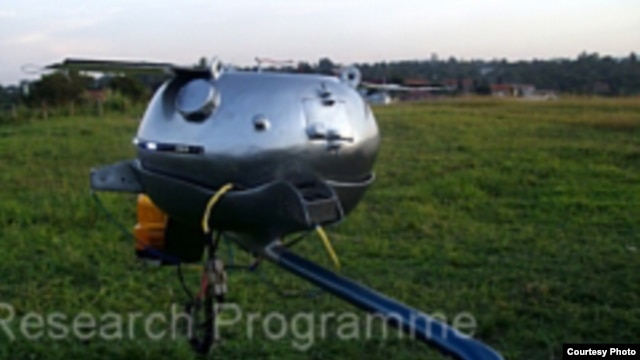
NASA's X1 was designed to help astronauts live in space, but could also be used to help disabled people walk.
*******************************************************************
NASA is credited with the invention of everything from the ear thermometer to water filters. Its latest invention, an exoskeleton - the same concept found in the Ironman comics - promises to augment astronaut’s bodies on deep space missions and even could help some disabled people regain the ability to walk.
The agency announced
its X1 robotic exoskeleton this week, a 51-pound robotic device that
humans wear over their bodies to supply resistance against leg movement.
NASA believes that X1 would be beneficial to astronauts who spend long
periods of time in zero gravity and face the possibility of acute muscle
atrophy.
X1 can also be reversed to assist movement in leg joints, and it is
designed to offer a broad range of motion to allow for natural
movements. NASA is keen on its benefits - both in space and on terra
firma.
“Robotics is playing a key role aboard the International Space
Station and will continue to be critical as we move toward human
exploration of deep space,” said Michael Gazarik, director of NASA’s
Space Technology Program. “What’s extraordinary about space technology
and our work with projects like Robonaut are the unexpected
possibilities space tech spinoffs may have right here on Earth.
“It’s exciting to see a NASA-developed technology that might one day
help people with serious ambulatory needs begin to walk again, or even
walk for the first time. That’s the sort of return on investment NASA is
proud to give back to America and the world,” Gazarik added.
This project is a spin off of NASA’s “Robonaut 2,” a robotic
astronaut that went online at the International Space Station in
February. It is being qualified for unmanned space travel scenarios, and
plugs into the station’s (solar) power system. It will eventually need a
lithium battery pack after NASA equips it with its own legs.
Other attempts at creating exoskeletons have been made in Europe.The French General Directorate for Armament has designed an exoskeleton called “Hercules” that will aid humans with heavy workloads; it can handle up to 220 pounds for up to a distance of 12 miles. Another project is underway at a California based start-up called Ekso Bionics. Its objective is assistive robots that help the disabled to walk, the Verge reports.
Autonomous robots for assistive care - the next frontier
Assistive care robots is another potentially big market. Tandy Trower, one of the original Microsoft employees, who was product manager when Windows first shipped, recently left the company to found a robotics start-up called Hoaloha Robotics
after Microsoft passed up on the opportunity. Trower is presently
researching how to get beyond some technology challenges, as it is still
early stage.
“I’m indeed continuing to work on my objective of developing a
commercially viable, autonomous, socially interactive robot companion to
support the increasing number of seniors who face, not only the
challenges of aging, but a shrinking supply of human resources. Add to
that the growth will come from the independently thinking and tech savvy
baby boomers and it results in a significant opportunity and more
importantly, social need for what I am doing,” he wrote in an e-mail.
Trower noted that most current technologies (Vgo, Double Robotics,
Suitable Technologies, Anybots, etc.) are remote telepresence robots,
which means that human-operators are required at the other end to
control the robot, he explained.
“In contrast, I am designing a robot that operates autonomously and
conversationally with the user. The closest analogy is Apple’s Siri, but
even Siri is a limited model in that Siri only interacts when the user
wants to ask it a question. If you have an upcoming event (or in my
audience medication), even Siri doesn’t pop-up and remind you. Further
Siri only provides a voice interface to a limited set of functions on
the iPhone,” he continued.
“Intuitive Automation’s Autom (weight loss coach) is another distant
comparison. But while Autom embodies similar principles in terms of
interaction with what we are building, Autom is stationary (sits on a
desktop or counter), offers only touch interaction, and is limited to
one application. So my endeavor takes quite a bit more than anything
presently on the market, and yet will be targeted to cost less than most
of the telepresence robots out there (I am targeting a price point
between $5000-$10,000).”
Source : Smart Planet






 ATLAS is expected to spot half of the 160-foot asteroids in the solar
system and two-thirds of the 460-foot planet killers that are thought
to be floating around us. This would give people in the impact zone
anywhere from a few days to a few weeks to evacuate, depending on the
size of the rock. And though the system's detection rate will likely
never top 75 percent, it will coordinate with other space-based comet
catchers like the NEO and Pan-STARRS telescopes, which peer further but over a smaller swath of sky, to maximize their coverage. "We
want to put ourselves in the way of discovering the unexpected," Tonry
said. As such, the ATLAS should also be able to track more benign
astronomical events like supernovas, variable stars, gravity waves, and
asteroid impacts out in the Kuiper belt.
ATLAS is expected to spot half of the 160-foot asteroids in the solar
system and two-thirds of the 460-foot planet killers that are thought
to be floating around us. This would give people in the impact zone
anywhere from a few days to a few weeks to evacuate, depending on the
size of the rock. And though the system's detection rate will likely
never top 75 percent, it will coordinate with other space-based comet
catchers like the NEO and Pan-STARRS telescopes, which peer further but over a smaller swath of sky, to maximize their coverage. "We
want to put ourselves in the way of discovering the unexpected," Tonry
said. As such, the ATLAS should also be able to track more benign
astronomical events like supernovas, variable stars, gravity waves, and
asteroid impacts out in the Kuiper belt. 












